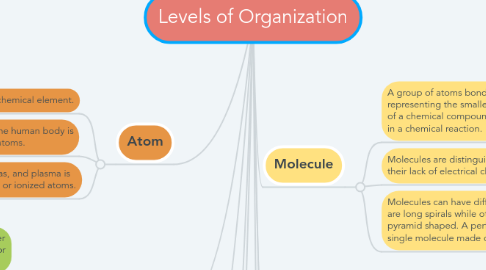Levels of Organization
by Delainie Pearson

1. Atom
1.1. The basic unit of a chemical element.
1.2. 66% of the mass of the human body is made up of oxygen atoms.
1.3. Every solid, liquid, gas, and plasma is composed of neutral or ionized atoms.
2. Macromolecule
2.1. A molecule containing a very large number of atoms, such as a protein, nucleic acid, or synthetic polymer.
2.2. They are typically composed of thousands of atoms or more.
2.3. The most common macromolecules in biochemistry are biopolymers and large non-polymeric molecules.
3. Cells
3.1. The smallest structural and functional unit of an organism, typically microscopic and consisting of cytoplasm and a nucleus enclosed in a membrane.
3.2. Microscopic organisms typically consist of a single cell, which is either eukaryotic or prokaryotic.
3.3. Cells are the basic building blocks of living things.
4. Organs
4.1. A part of an organism that is typically self-contained and has a specific vital function, such as the heart or liver in humans.
4.2. The human brain is the body's control center, receiving and sending signals to other organs through the nervous system and through secreted hormones.
4.3. Humans have five vital organs that are essential for survival.
5. Organism
5.1. An individual animal, plant, or single-celled life form.
5.2. Organisms can be made up of just one cell.
5.3. Organisms are abiotic, or living, part of the environment.
6. Molecule
6.1. A group of atoms bonded together, representing the smallest fundamental unit of a chemical compound that can take part in a chemical reaction.
6.2. Molecules are distinguished from ions by their lack of electrical charge.
6.3. Molecules can have different shapes. Some are long spirals while others may be pyramid shaped. A perfect diamond is a single molecule made of carbon atoms.
7. Organelles
7.1. Any of a number of organized or specialized structures within a living cell.
7.2. The main organelles are nucleus, cell membrane, chloroplast, mitochondria, endoplasmic reticulum, cell wall and golgi apparatus.
7.3. Most are surrounded by internal membranes and can be seen in the light or the electron microscope.
8. Tissues
8.1. Any of the distinct types of material of which animals or plants are made, consisting of specialized cells and their products.
8.2. Muscular tissue is made of cells that are organized to shorten and produce force when they contract (smooth skeletal and cordine muscle).
8.3. Connective tissue is usually made of cells and extracellular fibers that hold structures together (tendons), protect them (cartilage), store energy (fat), or produce blood.
9. Organ-system
9.1. An organ system is a group of organs that work together to perform one or more functions.
9.2. Each does a particular job in the body, and is made up of certain tissues.
9.3. Other organ systems in the human body include the immune system and the lymphatic system.


